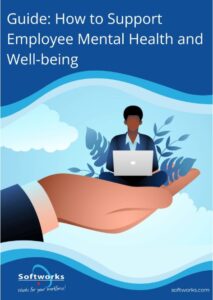Taking care of employees’ mental health and well-being is more important than ever in the hectic workplace of today. A workplace that puts these factors first not only protects the members’ emotional and physical well-being but also paves the way for an environment teeming with creativity, dedication, and everlasting devotion.
In light of this, we provide a structured guide to help businesses create a supportive and understanding environment that will have a significant positive influence on the lives of their teams.
TABLE OF CONTENTS
- Cultivate a Culture of Openness and Acceptance
- Offer Flexible Work Arrangements
- Ensure Access to Mental Health Resources
- Advocate for Regular Breaks and Vacations
- Support Struggling Employees
- Set the Right Example
- Foster Growth and Development
- Recognize and Reward Efforts
- Build a Positive Work Environment
1. Cultivate a Culture of Openness and Acceptance
The first step in supporting employee mental health is fostering an environment where open dialogue is not only permitted but encouraged.

Promote Open Dialogue: In many workplaces, mental health remains a stigmatized or taboo topic. Break this cycle by actively encouraging employees to speak about their experiences and feelings without any apprehension of prejudice or retribution. Holding regular check-ins, creating safe spaces for discussions, or even having occasional guest speakers can initiate these essential conversations.
Provide Mental Health Training: Merely encouraging conversation isn’t enough. Managers, HR personnel, and even peers should be equipped with the skills to recognize potential signs of mental distress or illness. Offering workshops or courses on mental health awareness can empower the team to approach such situations with sensitivity, understanding, and the requisite knowledge.
Encourage Peer Support: Often, employees find solace in sharing their experiences with colleagues who might be going through similar challenges. Foster this camaraderie by setting up support groups, hosting team-building activities centered around well-being, or introducing mentor-mentee systems. Such initiatives not only help employees feel less isolated but also build stronger, more interconnected teams.
2. Offer Flexible Work Arrangements
The traditional 9-to-5 work structure may not cater to everyone’s needs, especially in our evolving global workspace. By offering flexible work arrangements, employers can accommodate diverse lifestyles, reduce stress, and ensure optimal productivity.

Remote Work: The ability to work remotely can be a game-changer for many employees. It not only eliminates daily commute stress but also allows individuals to choose an environment where they’re most comfortable and productive. Whether it’s from home, a coffee shop, or another city, giving employees the option to work remotely can lead to increased job satisfaction and overall well-being.
Flexitime: Everyone operates on different internal clocks. Some people are morning birds, while others are night owls. By offering flexible start and end times, you’re allowing employees to work during their peak hours of productivity. This approach can lead to better work quality, reduced burnout, and a more balanced personal life.
Compressed Workweeks: While the concept might seem unconventional, compressed workweeks can have surprising benefits. By working longer hours over fewer days, employees can enjoy extended weekends. This schedule can provide a more substantial, uninterrupted break, allowing for better relaxation and personal time.
Incorporating these flexible work arrangements emphasizes an employer’s trust in their employees, and in return, can foster a stronger sense of responsibility, loyalty, and job satisfaction among the team.
Learn more: Managing Flexible Working with Softworks
3. Ensure Access to Mental Health Resources
While creating a supportive work environment is crucial, it’s equally essential to provide tangible resources that employees can turn to when they’re facing challenges. Here’s how employers can make a difference:

Employee Assistance Programs (EAPs): EAPs are invaluable assets that can offer a range of services, from counseling to legal advice. Ensure that employees are aware of these programs and are encouraged to utilize them when needed. Regularly introducing or highlighting the advantages of EAPs can make it more likely that employees will seek out this support in times of need.
Health Benefits: A robust health insurance plan should not overlook mental health. Ensure that the insurance you offer covers consultations with therapists, psychologists, or psychiatrists. Furthermore, periodic mental health check-ups can be introduced as a proactive measure, emphasizing the company’s commitment to its employees’ holistic well-being.
Referral Services: Sometimes, the challenges employees face might require specialized attention. In such instances, having a system in place to refer them to relevant mental health professionals can be invaluable. Maintain a network or list of reputable counselors, therapists, and other mental health practitioners. Making the process of finding professional help seamless can make a world of difference for someone in distress.
By proactively offering these resources, employers send a clear message: the mental well-being of their employees is a top priority. This proactive approach not only aids individuals in times of crisis but also promotes a broader culture of care and understanding within the organization.
4. Advocate for Regular Breaks and Vacations
Continuous work without respite can lead to burnout, decreased productivity, and diminished creativity. To foster a truly sustainable and healthy work environment, it’s imperative for employers to emphasize the significance of regular breaks and vacations.

Prioritize Downtime: Short, frequent breaks during the workday can boost overall productivity and creativity. Remind employees about the value of stepping away from their desks, whether it’s a five-minute stretch, a brief walk, or even a short meditation session. Encouraging tools like the Pomodoro Technique, where individuals work intensively for a set period and then take a short break, can also be effective. Such moments of respite can rejuvenate the mind, leading to more efficient and innovative work.
Encourage Vacation Time: Vacation isn’t just a luxury; it’s a necessity for mental rejuvenation. Employees should be prompted to utilize their allocated vacation days fully. Whether it’s a long holiday or a short weekend getaway, time away from the office can help in distancing oneself from daily stresses and returning with a refreshed perspective. Employers can further motivate this by ensuring a seamless handover process, so employees don’t fret about work piling up in their absence.
Promoting a balance between work and rest isn’t just beneficial for employees; it’s advantageous for the organization as a whole. Rested, relaxed employees bring more enthusiasm, creativity, and energy to their roles, contributing to a thriving and dynamic workplace.
Learn more: Absence Management with Softworks
5. Support Struggling Employees
Every individual faces personal challenges at various stages in their life. In these moments, the support and understanding from employers can make a significant difference. Here’s how organizations can stand by their team members during their tough times:

Show Empathy: At the core of any supportive workplace is genuine empathy. Recognize the signs when someone is struggling, and approach them with kindness and understanding. A simple check-in, asking how they are or if they need any support, can go a long way. Ensure that these conversations are held privately, respecting the employee’s confidentiality, and creating an environment where they feel safe to express their feelings and concerns.
Offer Additional Time Off: Everyone’s recovery and coping mechanisms are different. While some might need a day or two to regroup, others might require extended periods to deal with personal challenges. Be flexible and understanding, offering additional time off when needed. This gesture not only supports their mental well-being but also reinforces their trust and loyalty towards the organization.
Assist in Resource Navigation: In moments of distress, navigating the myriad of available resources can be overwhelming. Assist employees by pointing them to relevant services, whether it’s the company’s Employee Assistance Program, a trusted therapist, or even community support groups. Having a pre-established list of resources or contacts can be beneficial in such situations.
Supporting employees in their times of need isn’t just about workplace ethics; it’s about human decency. By extending a helping hand when they’re down, organizations can build an environment of trust, loyalty, and mutual respect, where employees feel valued beyond just their professional contributions.
6. Set the Right Example
Leadership is not just about guiding and instructing; it’s about leading by example. Employees often look up to their superiors for cues on work behaviors and habits. By modeling healthy work practices, employers can set the standard for the entire organization.

Model Work-Life Balance: Demonstrating a healthy balance between work and personal life can significantly influence your team. If you, as a leader, make it a point to take regular breaks, avoid sending emails during non-working hours, and emphasize the importance of downtime, it sets a precedent for your employees to do the same. By practicing and valuing work-life balance, you send a clear message about its significance in the organization.
Maintain a Balanced Workload: It’s essential to keep a pulse on how much work each employee is handling. Continually pushing team members to their limits or setting unrealistic expectations can lead to burnout and decreased morale. Regular check-ins or feedback sessions can help in gauging workloads. When you actively work towards ensuring that no one is overwhelmed, it showcases a commitment to their well-being.
Employers hold a unique position of influence within an organization. By actively embodying the values and behaviors they wish to see, they can pave the way for a healthier, more balanced, and more supportive workplace culture.
Learn more: Improving Work-Life Balance with Softworks
7. Foster Growth and Development
Personal and professional growth are fundamental drivers of job satisfaction. When employees feel they are advancing and evolving, they’re not only more engaged but also mentally stimulated and motivated. Investing in your team’s development is an investment in the organization’s future. Here’s how to cultivate an environment that prioritizes growth:

Learning Opportunities: Continuous learning keeps the mind agile and can be a source of rejuvenation. Offer a variety of learning opportunities, be it workshops, online courses, seminars, or even book clubs. Encourage employees to explore areas of interest outside of their primary job roles. By facilitating or subsidizing such programs, employers underscore the importance of holistic development.
Career Growth: Every employee wishes to see a clear path of progression in their career. Create transparent frameworks for advancement within the organization. Regular performance reviews, feedback sessions, and open conversations about career aspirations can help in charting clear paths. Additionally, provide opportunities for employees to take on new responsibilities or projects, allowing them to hone and acquire new skills.
A workplace that emphasizes growth and development not only retains talent but also attracts it. When employees feel valued and see tangible opportunities for progression, it fosters a sense of loyalty, dedication, and overall well-being, creating a synergistic environment where both the organization and its members thrive.
8. Recognize and Reward Efforts
Recognition is a powerful motivator. When employees feel seen and appreciated for their contributions, it boosts their morale, increases motivation, and fosters a sense of belonging. Beyond just monetary compensation, genuine acknowledgment can make a world of difference in the daily work experience of an individual. Here’s how to effectively integrate recognition into the workplace:

Regular Feedback: While annual reviews have their place, the power of consistent feedback shouldn’t be underestimated. Regular check-ins, where managers not only discuss areas of improvement but also highlight successes and efforts, can be incredibly uplifting for employees. Celebrate small victories and milestones, ensuring that hard work doesn’t go unnoticed.
Reward Systems: Establishing a structured system for rewards can further enhance the sense of recognition. This can range from ‘Employee of the Month’ programs to bonuses for exceptional work, from public commendations in team meetings to even smaller gestures like gift cards or an extra day off. The key is to tailor the reward to both the accomplishment and the preferences of the employee, making the recognition feel personal and meaningful.
By consistently recognizing and rewarding efforts, organizations nurture a positive, motivating atmosphere where employees feel valued. Such an environment not only bolsters individual well-being but also promotes team cohesion and elevates the overall work culture.
9. Build a Positive Work Environment
The ambiance and culture of a workplace play a pivotal role in shaping employees’ mental well-being and overall job satisfaction. An environment that radiates positivity, respect, and inclusivity can uplift the spirits of its members, fostering creativity and collaboration. Here’s how to cultivate such a nurturing setting:

Valued and Respected: Every individual wants to feel that their contributions matter. To foster this, regularly highlight and acknowledge the unique skills and talents each employee brings to the table. Ensure that everyone, regardless of their position or tenure, feels heard and appreciated. An open-door policy, where employees can voice concerns or share ideas without fear of dismissal, can further this sentiment.
Healthy Interactions: Relationships at work are a significant factor in an individual’s daily experience. Promote positive communication by setting clear guidelines on respectful interactions and discouraging any form of workplace bullying or discrimination. Encourage team-building activities, whether it’s a team lunch, a weekend retreat, or simple ice-breaker games during meetings. Such interactions allow team members to bond, understand each other better, and foster a sense of community within the workplace.
By laying the foundation for a positive work environment, employers pave the way for a harmonious, productive, and innovative space. When employees look forward to coming to work, knowing they’re stepping into a supportive and vibrant atmosphere, it not only benefits their mental well-being but also the overall success of the organization.
Conclusion
In the fast-paced world of the modern workplace, prioritizing employee mental health and well-being is not just a noble endeavor but a business imperative. As clearly laid out in the aforementioned steps, fostering an environment where employees feel valued, heard, and supported leads to numerous benefits. From increased productivity and creativity to reduced turnover rates and enhanced team dynamics, the advantages are manifold.
At its core, this journey toward a supportive workplace hinges on a few key principles: open communication, genuine empathy, flexibility, and continuous learning and recognition. Whether it’s about advocating for regular breaks, promoting growth, or building a positive work environment, each initiative is a step towards creating a holistic space where every individual feels they belong and can thrive.
In today’s dynamic business landscape, organizations that take proactive measures to ensure the mental well-being of their employees are not only set to enjoy enhanced performance but also position themselves as industry leaders. It is a testament to the ethos that when you take care of your employees, they, in turn, take care of the business. The future belongs to organizations that recognize this symbiotic relationship and take concrete steps to nurture it.
Request a free Demo!
Take the first step towards a complete workforce management solution. Talk to us today!
About Tomislav Rucevic
Tomislav Rucevic, an SEO Specialist at Softworks, stands out as more than just a marketer. He’s a fervent writer and influential thinker passionate about Workforce Management, HR, and work-life dynamics. Holding an MBA in Marketing, Tomislav excels in creating content that delves into the complexities of the modern workplace.
His dedication to writing on these topics is highlighted in his MBA thesis, which examined the link between Employee Motivation and Quality Improvement. At Softworks, he expertly merges his SEO skills with his writing prowess, contributing to the company’s digital success and advancing discussions on enhancing work environments and achieving work-life balance.










